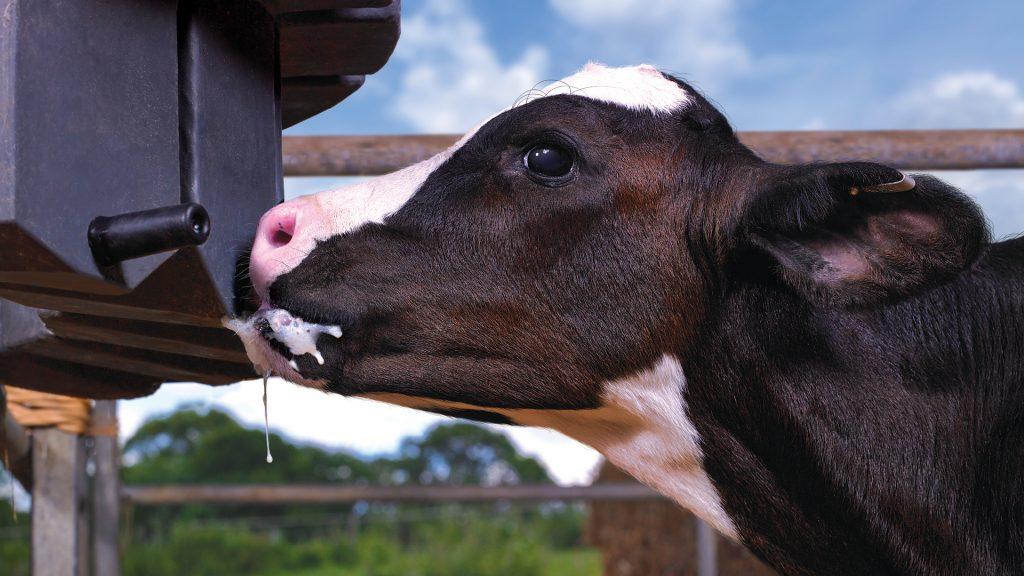Explore if transition milk or milk replacer is better for your calves’ health and growth. Which one works best?
Summary: Have you ever wondered if there’s a better way to feed your young dairy calves? Many farmers are turning their attention to Transition Milk (TM). This special milk, produced from the second to the sixth milking after calving, packs more energy, protein, and essential bioactive compounds than mature milk. But does it offer significant advantages over traditional milk replacer (MR)? Calves fed TM have shown a growth increase of 0.3 kg/day, enhanced digestion, improved eye, ear, and nasal health scores, and increased body weight gain, heart girth, and hip height [Shiraz University Study]. However, TM has practical challenges like its perishable nature, variable daily supply, and more labor-intensive processes. Balancing these factors can help determine if TM is the right choice for quicker growth rates and better health scores for your calves or if MR’s simplicity and consistency make it the better option.
- Transition Milk (TM) is used from the second to the sixth milking after calving.
- TM contains higher energy, protein, and bioactive compounds than mature milk.
- Feeding TM can increase calves’ growth by 0.3 kg/day.
- TM-fed calves show enhanced digestion and better overall health scores.
- Improved calf health includes better eye, ear, and nasal health, increased body weight gain, heart girth, and hip height.
- TM has practical challenges, such as its perishable nature and variable daily supply.
- Choosing between TM and Milk Replacer (MR) involves weighing quicker growth and health benefits against the simplicity and consistency of MR.

Have you ever wondered what may help your dairy calves get a jump start in life? As a dairy farmer, you understand their early health and development are critical. But did you realize that the milk you give them may make all the difference? Transition milk (TM), generated between the second and sixth milkings after calving, contains more calories, protein, immunoglobulins, and beneficial substances than mature milk. Conversely, milk replacer (MR) is a popular option. However, calves given TM grew 0.3 kg/day faster than those fed MR, owing to improved digestion and nutritional absorption. Understanding these distinctions may help you make better choices for your herd.
So, What Exactly is Transition Milk?
So, what precisely constitutes transition milk? It is the nutritious milk produced between the second and sixth milking after a cow gives birth. During this brief period, transition milk has a distinct makeup that sets it apart from mature milk.
Transition milk is more caloric-dense, protein-rich, and contains more immunoglobulins than mature milk. These components are critical to the growth and well-being of newborn calves. The added energy encourages calves to grow more vigorously, while the extra protein aids muscular growth. Immunoglobulins strengthen calves’ immune systems, enabling them to fight off viruses and health difficulties early in life.
Understanding this explains why there is a rising interest in utilizing the advantages of transition milk in dairy production. Transition milk significantly increases growth rates and improves overall calf health.
Let’s Dig into the Benefits of Feeding Transition Milk (TM) to Your Calves
Let’s examine the advantages of providing your calves with transition milk (TM).
First, consider growth rates. Shiraz University found that feeding calves 4.3 liters of TM per day for three days resulted in 0.3 kg/day more development than milk replacer (MR) [source]. That represents a significant increase due to the calves digesting their diet more effectively.
Digestion is another area where TM excels. The calves on TM demonstrated enhanced digestion, which is crucial for absorbing nutrients required for development and general health. Improved digestion frequently results in a more robust, healthier animal.
Last but not least, let us consider health indices. A Shiraz University research indicated that calves fed TM had improved eye, ear, and nasal health ratings compared to those given MR. These improvements in health indicators result in fewer problems and possibly decreased veterinarian bills.
Feeding TM to young calves has various benefits. If you have access to this nutrient-dense milk, it may be worth including in your feeding plan.
The Practical Hurdles of Using Transition Milk (TM)
While the advantages of providing Transition Milk (TM) to your calves are apparent, we must recognize the obstacles that come with it. Have you ever thought about the practical challenges you could face?
Unlike milk replacer (MR), TM is a perishable product. To keep it fresh, use proper refrigeration or other preservation procedures. Can you manage this additional requirement?
Variable Daily Supply: TM is only accessible between the second and sixth milking following calving. This restricted time frame might result in irregular supply. How will you handle feeding schedules if supplies fluctuate?
Increased Labor: Preparing and managing TM requires more processes and monitoring than MR. This extra work could impact you if you are already slim. Is your staff prepared for the added workload?
While TM has many benefits, evaluating these practical issues can help you better select your dairy farm. Balancing the advantages and disadvantages of TM may result in healthier, flourishing calves.
Why Milk Replacer Is a Go-To for Many Dairy Farmers
Let’s look at milk replacers and why they are so popular among dairy producers. Milk replacer (MR) is a formula that mimics the nutritional profile of cow’s milk, making it a viable option for feeding calves. The convenience factor is one of the primary reasons for its appeal. Unlike transition milk, which may be variable in availability, milk replacer is a constant and dependable solution. This constancy guarantees that your calves are always satisfied, regardless of the time or circumstance.
The convenience of usage is also unparalleled—no need to chill or store the product indefinitely. You combine it, and it’s ready to use. This basic strategy may save you time and work while ensuring your calves get the necessary nourishment.
Transition Milk vs. Milk Replacer: A Comparative Breakdown
| Aspect | Transition Milk (TM) | Milk Replacer (MR) |
|---|---|---|
| Nutrition Value | Higher in energy, protein, and bioactive compounds | Standardized and consistent in nutrient content |
| Growth Benefits | Increased growth rate, body weight gain, heart girth, and hip height | Adequate for growth but lower performance compared to TM |
| Health Benefits | Improved eye, ear, and nasal health | Good overall health but not as strong as TM in specific areas |
| Gut Function | Supports better gut health and function | Standard gut health support is not as enhanced as TM |
| Supply Consistency | Variable daily supply, dependent on fresh cow milking | Consistent and reliable supply |
| Storage and Preservation | Perishable require proper storage and handling | Less perishable; more accessible to store and manage |
| Labor and Management | More labor-intensive due to handling and preservation needs | Less labor-intensive; easier to prepare and feed |
Cost-Benefit Analysis: Transition Milk (TM) vs Milk Replacer (MR)
Production Costs
Let us start with production. Transition Milk (TM) is a byproduct of your current milking process, especially the second to sixth milkings after calving; hence, no direct production expense is involved. However, the reality of farming is that your TM supply will change according to your calving calendar. Milk Replacer (MR) is in constant supply. However, it is an extra purchase with continuous expenses determined by your formula and provider. On average, you may spend between $1.50 and $2 per calf every day on MR [Cornell Dairy Extension]
Storage and Labor Costs
Storage and labor will come next. Transition Milk requires special handling since it is perishable and must be chilled quickly to retain quality. This might include purchasing more refrigerated units and arranging manpower for milking, collecting, and storage. On the other hand, MR is available in a dry, easy-to-store form that is less labor-intensive but usually needs mixing before feeding. The convenience of MR storage may save you essential time and labor expenses in the long run.
Health and Growth Benefits
Now consider the financial benefits: more excellent health and growth. According to studies, calves given TM develop at 0.3 kg/day faster than those fed MR. These TM-fed calves also had superior general health, which might result in cheaper vet expenses, lower mortality rates, and more long-term production. These improvements might result in significant financial gains. Healthy and faster-growing calves may achieve weaning and market weights sooner, resulting in a faster return on investment [SpringerLink Study]
In the end, the option is not apparent. Transition milk may provide considerable health and development advantages but requires more complicated Management and a fluctuating supply. Milk Replacer is consistent and straightforward to store, although it may not be as nutritionally dense as TM. Consider these considerations carefully to decide the best method for your operation’s requirements and circumstances.
Making the Smart Choice: Transition Milk or Milk Replacer for Your Calves?
When choosing between Transition Milk (TM) and Milk Replacer (MR), consider what makes the most sense for your farm’s unique setup. Are you aiming for quicker growth rates and better health scores? If so, TM might be the better option for you. However, ask yourself these key questions:
- Do you have the labor to manage feeding TM? TM requires careful storage and handling to prevent spoilage.
- Is your daily supply of TM consistent? Inconsistent availability can disrupt the benefits of feeding TM to your calves.
- What are your goals? If quick growth and overall health of calves are top priorities, the additional effort of feeding TM could be worthwhile.
So, how do you implement TM efficiently if you choose to go down that route? Here are some practical tips:
- Identify a Reliable Source of TM: Ensure you consistently collect TM from your herd.
- Proper Storage: Refrigeration or freezing methods to preserve TM’s quality. Remember, TM is perishable!
- Determine a Feeding Schedule: Create a consistent feeding routine to maximize TM’s benefits. Research highlights better growth rates for calves on reliable feeding schedules.
- Monitor Health and Growth: Monitor your calves’ progress. Note improvements in weight gain, gut health, and overall vitality.
If TM seems too big of a logistical burden, don’t worry. MR provides a more accessible and regulated feeding method. While it may not offer the same quick growth advantages as TM, its constancy may result in efficient and consistent calf development.
Ultimately, the decision concerns what best fits your farm’s resources, labor skills, and goals. Consider what is practicable for you and make any required modifications to promote your calves’ health and development.
The Bottom Line
To summarize, providing transition milk (TM) to your calves has several advantages, ranging from increased growth rates to better health outcomes, all supported by extensive research. However, weighing these benefits against practical obstacles such as preservation concerns and intermittent supplies is critical. Despite the possibility of decreased development, milk replacer (MR) remains a mainstay for many dairy producers due to its simplicity and consistency.
Consider the nutritional and economic implications while deciding on a herd management strategy. Could the benefits of TM warrant the extra work, or does the reliable nature of MR better suit your farm’s needs?
So, what are your next steps for improving calf health and growth? Dive deeper into your farm’s conditions, and be bold and experiment or seek guidance from other farmers. Remember that the most outstanding selection corresponds with your objectives and available resources.













